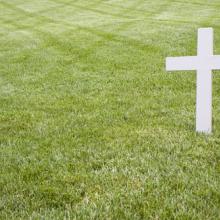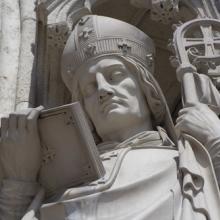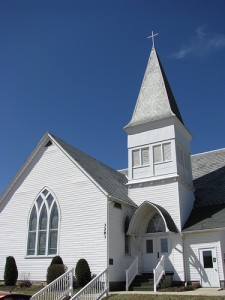gallup poll

(left) Donald Trump at the CNN Republican debate Dec. 15 in Las Vegas. Joseph Sohm / Shutterstock.com. (right) Pope Francis celebrates Mass on June 21 in Turin, Italy. miqu77 / Shutterstock.com
Americans’ most admired man and woman in the world are — once again — President Barack Obama and former Secretary of State Hillary Clinton.
But the shocker in the Gallup Poll’s Most Admired List released Monday may be the No. 2 spot in the survey, where Donald Trump tied Pope Francis in the year the pontiff visited this country for the first time.
More Utahns go to church every week — 51 percent — than any other state, according to a new Gallup poll.
That statistic is “a direct result of (Utah)’s 59 percent Mormon population,” Gallup’s Frank Newport writes, “as Mormons have the highest religious service attendance of any major religious group in the U.S.”
The next most-frequent church attendees are in the South — Mississippi (47 percent), Alabama (46 percent), Louisiana (46 percent), and Arkansas (45 percent). In fact, 10 of the top 12 churchgoing states are in the South.
At the bottom of the list is Vermont, Gallup reports, “where 17 percent of residents say they attend religious services every week,” Newport writes. Just ahead of the Green Mountain State are New Hampshire (20 percent), Maine (20 percent), Massachusetts (22 percent), Washington (24 percent), and Oregon (24 percent). Half the bottom 10 are in New England.
Most Christians don’t approve of President Obama right now, but he gets high ratings from Muslims and other minority religious groups.
It’s not because of their religion, though.
Obama’s level of popular approval matches Americans’ political party ties, not their religious identity, age or almost any other demographic characteristic, said Jeffrey Jones, managing editor of the Gallup poll.
The newest Gallup tracking poll shows the president’s approval rating in June averaged 43 percent for Americans overall. However, his ratings sank with Catholics to 44 percent, down from 54 percent in June 2013.
Americans are showing more tolerance for a range of behaviors, with sex between unmarried adults, medical research on stem cells from human embryos, and doctor-assisted suicide all showing record highs and increases in “moral acceptability” from last year .
The Gallup poll’s annual “moral acceptability” scale has been conducted since 2001 and charts shifting cultural attitudes on a number of hot-button social issues. In the 2014 list released Friday, Gallup researchers said 12 of the 19 categories reflected “levels of moral acceptance that are as high or higher than in the past.”
“Americans largely agree about the morality of several issues,” Gallup researchers said. “Most say birth control is acceptable but that extramarital affairs are wrong. However, other issues show clear, substantial divides. These differences are largely explained by party identification, but previous research has shown that age also plays a factor.”
Three issues — sex between an unmarried man and woman, medical research on embryonic stem cells, and doctor-assisted suicide — showed a slight increase in acceptability from 2013. Most of the other issues were mostly unchanged.
For over half a century, Gallup has been asking Americans whether they think the influence of religion is increasing or decreasing in the U.S., posing the intriguing question of what the results actually signify.
For starters, it’s worth bearing in mind that Western civilization is grounded in the belief that once upon a time, God was in his heaven and people went to church regularly. So at any given time, more Americans are likely to think the influence of religion is in decline than the other way around.
That said, what accounts for the rather striking ups and downs in the chart? In its latest release, Gallup emphasizes that these do not reflect changes in personal religiosity — and I’m inclined to agree, up to a point. Here’s the story I’d tell about the people’s perception of religion’s influence.
Among the list of U.S. institutions—banks, the medical system, the U.S. Supreme Court, Congress—where would you pin organized religion?
According to a recent Gallup poll, it comes in fourth, falling behind the military, small business, and police. Only 44 percent of Americans have a "great deal" or "quite a lot" of confidence in the church—a downward fall that has been the trend since its height in the 1970s.
Drilling down, Protestants tend to have higher confidence—56 percent—in their churches than Catholics, who fall in at 46 percent. (Commentary is linking this to the child abuse scandals.)
Organized religion isn't alone in this. The overall lack of confidence in American institutions is evident across the board, with television news at 21 percent and Congress at an abysmal 13 percent. Even public schools come in at 29 percent.
But is this at all surprising?
In the 2012 race for the presidency, religious voters will continue to be watched closely.
According to Gallup’s latest poll, Mitt Romney leads Barack Obama by 17 points among “very religious voters.” These voters are those who attend religious services on a weekly basis (or nearly every week), and are estimated to constitute 41 percent of registered voters.
On the other hand, the report shows that Barack Obama has a 14 point lead among “moderately religious voters” and a 31 point lead among “non-religious voters.”
But this really isn’t anything new. Gallup reports that these findings “reinforce a basic pattern in American voting behavior that has been evident for decades.” The highly religious favor the Republican, the not-quite-as-religious favor the Democrat. This also confirms previous Gallup findings in their "state of the state" report, last month.
The more church you attend, the more likely you are to vote Republican. That's one of the findings from Gallup’s comprehensive study on U.S. states and their religious commitments (or lack thereof). And the data they account seems consistent with our current political climate.
According to Gallup’s “state of the states,” 40 percent of Americans are “very religious,” meaning they attend a service almost every week and believe religion is important to daily life. On the flip side, 32 percent are “nonreligious,” they don’t attend services regularly and don’t believe religion is important to daily life. The remaining 28 percent are “moderately religious,” they may believe religion is important but do not attend services themselves, or they may attend services but think it unimportant to daily life.






